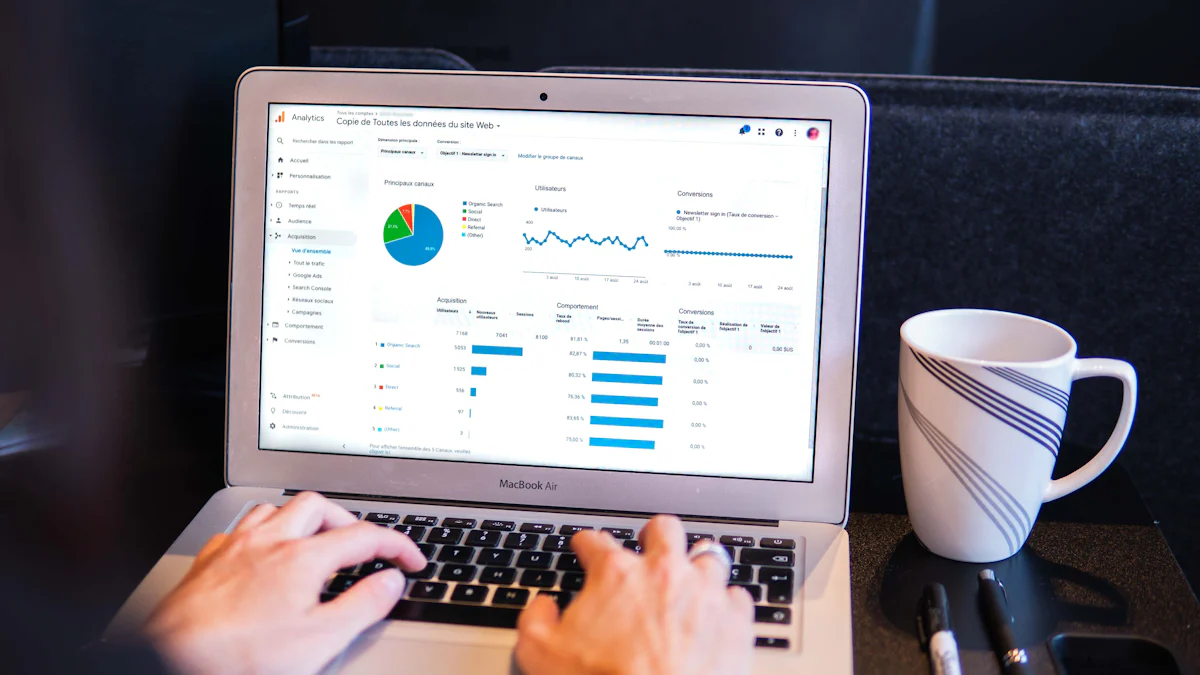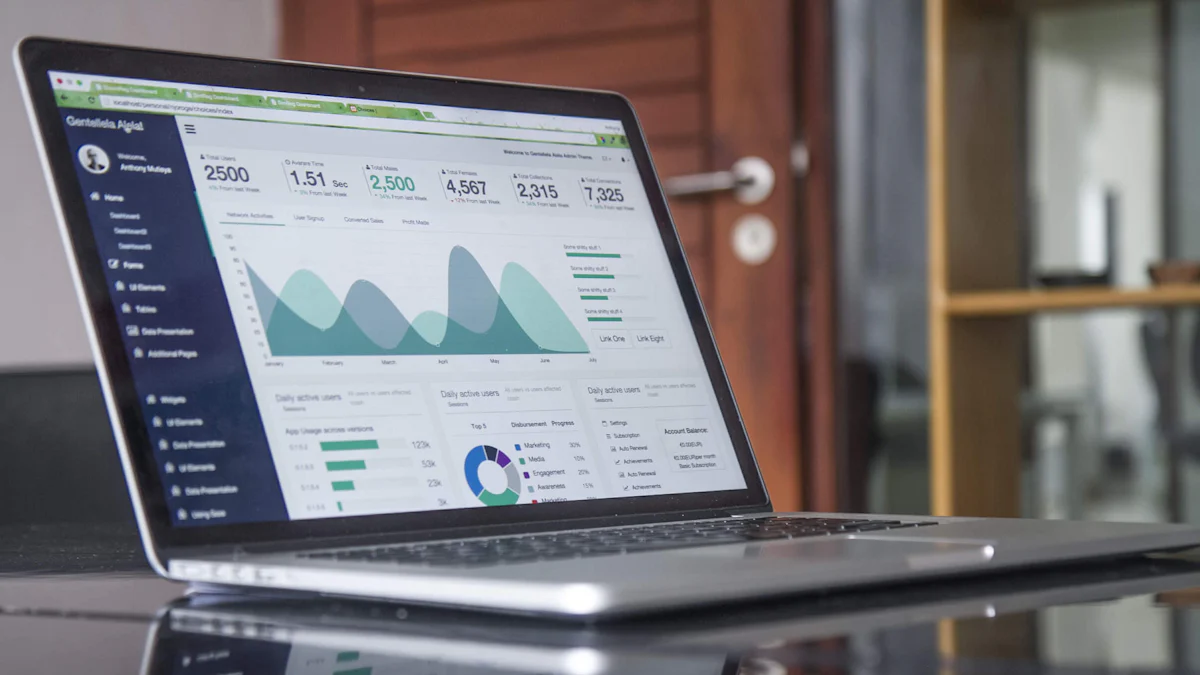What Are the Key Metrics in Influencer Marketing Analytics

Tracking influencer marketing metrics is essential for ensuring your campaigns succeed. These metrics help you evaluate immediate outcomes, such as likes and shares, while also offering insights into long-term impacts like audience relationships and brand equity. By setting clear objectives and monitoring performance indicators, you can measure the effectiveness of your influencer partnerships. For example, 81% of US-based social marketers consider influencer marketing a vital part of their strategy, with goals like increasing positive brand mentions by 20% or generating 500 leads.
However, challenges like determining ROI or identifying authentic engagement often complicate the process. High follower counts may not always reflect genuine interactions due to fake followers or bots. Despite these hurdles, businesses that track influencer marketing analytics effectively report an average ROI of $6.50 for every $1 spent, with top performers achieving $20 or more. These insights empower you to optimize strategies and build stronger influencer relationships, enhancing campaign authenticity and results.
Reach and Impressions in Influencer Marketing Analytics

Defining Reach and Impressions
Reach and impressions are two key metrics in influencer marketing. Reach refers to the total number of unique individuals who see your content. Impressions, on the other hand, represent the total number of times your content is displayed, including multiple views by the same person. While reach measures the breadth of your audience, impressions highlight the frequency of exposure. Together, these metrics help you understand how far your influencer campaign extends and how often your audience interacts with the content.
Importance of Reach and Impressions for Campaign Visibility
Tracking reach and impressions is essential for understanding the visibility of your influencer marketing efforts. These metrics provide valuable insights into how well your campaign performs.
- Audience Exposure: Reach shows how many unique users see your content, while impressions reflect the total number of displays. Higher numbers increase brand awareness.
- Campaign Visibility: These metrics reveal how widely your content is seen, helping you justify costs and assess potential impact.
- Cost-Effectiveness: Comparing reach and impressions to costs allows you to calculate CPM (cost per thousand impressions) and compare it with other marketing channels.
- Audience Targeting: Analyzing these metrics ensures your campaign reaches the right audience, helping you refine your strategy.
- Content Performance: Comparing reach and impressions across posts helps you identify which content resonates most with your audience.
- Frequency and Saturation: The ratio of impressions to reach shows how often users see your content, helping you determine the optimal posting frequency.
Measuring Reach and Impressions
Tools for Tracking
You can measure reach and impressions using several tools. Social media platforms like Instagram, Facebook, and TikTok provide built-in analytics to track these metrics. Influencer platforms also offer detailed reports, making it easier to monitor performance. For more advanced tracking, you can use third-party tools that integrate with your campaigns to provide deeper insights.
Examples of Metrics
When tracking reach and impressions, focus on specific metrics to evaluate your campaign. Total reach shows the number of unique viewers, while unique impressions measure how often your content is displayed to individual users. You can also calculate engagement by reach or impressions. For example, divide total interactions (likes, comments, shares) by total reach or impressions, then multiply by 100 to get a percentage. These calculations help you assess how effectively your content engages your audience.
Engagement Metrics in Influencer Marketing
What Are Engagement Metrics?
Engagement metrics measure how actively your audience interacts with the content shared by influencers. These interactions include likes, comments, shares, and clicks. Unlike reach and impressions, which focus on visibility, engagement metrics reveal the depth of audience connection. They help you understand whether your influencer campaign resonates with viewers and encourages meaningful actions. For example, a high engagement rate indicates that followers find the content relevant and are more likely to trust the influencer's recommendations.
Key Engagement Metrics to Track
Engagement Rate (likes, comments, shares divided by total reach)
Engagement rate is one of the most critical influencer marketing metrics. It calculates the percentage of people who interact with a post compared to those who see it. To find this, divide the total number of likes, comments, and shares by the total reach, then multiply by 100. A higher engagement rate often correlates with campaign success, as it shows that the influencer's audience is genuinely interested in the content. This metric also helps you compare influencers and identify those who can drive better results.
Click-Through Rate (CTR)
Click-through rate measures the percentage of viewers who click on a link within the influencer's content. It is essential for tracking influencer marketing success, especially when your goal involves driving traffic to a website or landing page. To calculate CTR, divide the total number of clicks by the total impressions and multiply by 100. A strong CTR indicates that the influencer's audience finds the call-to-action compelling and relevant.
Audience Growth Rate
Audience growth rate tracks how quickly an influencer's follower count increases during a campaign. This metric helps you evaluate the influencer's ability to attract new followers and expand your brand's reach. To calculate it, divide the number of new followers gained during the campaign by the starting follower count, then multiply by 100. A steady growth rate suggests that the influencer's content appeals to a broader audience.
Why Engagement Metrics Are Essential
Engagement metrics are vital for measuring influencer marketing success. They provide insights into how well your campaign connects with the target audience. High engagement rates often lead to better conversions, as engaged audiences are more likely to take action, such as purchasing a product or signing up for a service. These metrics also help you identify the most effective influencers for your brand. By tracking influencer marketing analytics, you can refine your strategy and achieve better results.
Tip: Use tools like social media analytics platforms to monitor engagement metrics in real-time. This allows you to adjust your campaign strategy as needed.
Tools for Measuring Engagement
You need reliable tools to measure engagement effectively in influencer marketing. These tools help you track how audiences interact with content, providing insights that refine your marketing strategies. High engagement rates show that your content resonates with viewers, which can strengthen brand loyalty and improve campaign outcomes.
Here are some tools and features you can use to measure engagement:
- Socialinsider: This tool excels at tracking campaign performance and analyzing engagement. It allows you to monitor likes, comments, shares, impressions, and engagement rates in real time. You can also generate detailed reports to evaluate your influencer campaign's success.
- Engagement Rate Analysis: Use this feature to compare influencer engagement rates against industry benchmarks. It helps you identify influencers who align with your goals and deliver better results.
- Streamlined Reporting: Tools offering streamlined reporting simplify the process of analyzing influencer marketing metrics. They provide comprehensive insights into campaign performance, making it easier to adjust your strategy.
- Competitor Campaign Analysis: Some platforms let you analyze competitor collaborations with influencers. This feature helps you understand what works in your industry and adapt your approach accordingly.
Social media platforms like Instagram, TikTok, and Facebook also provide built-in analytics. These tools allow you to track likes, comments, shares, and other engagement metrics directly. For example, Instagram Insights shows detailed data about post interactions, helping you assess content performance. Third-party platforms often integrate with these social media tools, offering advanced features like competitor analysis and real-time tracking.
By using these tools, you can monitor engagement metrics efficiently. This ensures your influencer marketing efforts remain on track and aligned with your goals.
Traffic and Conversions in Influencer Marketing Measurement
Understanding Traffic and Conversion Metrics
Traffic and conversion metrics help you evaluate how effectively an influencer campaign drives users to your website and encourages them to take desired actions. These actions could include making a purchase, signing up for a newsletter, or downloading an app. By analyzing these metrics, you can determine whether your campaign is achieving its goals and delivering a strong return on investment.
The relevance of the influencer’s audience plays a significant role in driving conversions. When their followers align with your target demographic, they are more likely to engage and take action. High-quality content also grabs attention and encourages users to click through to your website. Trust in the influencer’s recommendations further increases the likelihood of conversions. Lastly, a clear call-to-action ensures the audience knows exactly what to do next.
Key Metrics to Track
Website Traffic (e.g., referral traffic from influencer links)
Website traffic measures the number of visitors directed to your site through influencer links. This metric shows how well the influencer’s content drives interest in your brand. Tracking referral traffic helps you identify which influencers generate the most visits, allowing you to focus on high-performing partnerships.
Conversion Rate (e.g., purchases, sign-ups, downloads)
Conversion rate measures the percentage of visitors who complete a specific action, such as making a purchase or signing up for a service. This metric is crucial for measuring influencer marketing success. A higher conversion rate indicates that the influencer’s audience finds your offer compelling and relevant.
Bounce Rate
Bounce rate tracks the percentage of visitors who leave your site without taking any action. A high bounce rate may indicate that the landing page does not meet user expectations. Optimizing your website’s design and content can help reduce this rate and improve conversions.
How to Measure Traffic and Conversions
Using UTM Parameters
UTM parameters are essential for tracking traffic and conversions in influencer marketing measurement. These small snippets of text added to URLs help you identify the source of your website traffic. To use them effectively:
- Avoid redundant or irrelevant UTM parameters to simplify data analysis.
- Establish consistent naming conventions using lowercase letters and underscores.
- Use descriptive and specific UTM parameters for clarity.
- Document your naming conventions to ensure team familiarity.
Adding UTM codes to influencer links allows you to track which campaigns and influencers drive the most traffic and conversions.
Leveraging Google Analytics and Other Tools
Google Analytics is a powerful tool for measuring influencer marketing ROI. By setting up campaign parameters, you can track specific traffic sources and measure conversions effectively. Creating custom segments helps you isolate traffic from influencer campaigns and compare it with other channels. Using unique UTM parameters for each influencer reveals which collaborations yield the highest ROI. These insights enable you to refine your strategy and maximize results.
| Metric Type | Description |
|---|---|
| Purchase Conversion Rate | Percentage of social media visitors who complete a purchase on the website. |
| Lead Generation Conversion Rate | Percentage of social media visitors who fill out a form or sign up for a newsletter. |
| Click-to-Conversion Rate | Percentage of clicks on social media posts that result in a conversion. |
| Platform-Specific Conversion Rate | Conversion rate segmented by social media platform (e.g., Facebook, Instagram, Twitter). |
By combining UTM parameters and tools like Google Analytics, you can gain a comprehensive understanding of your influencer marketing analytics and optimize your campaigns for better results.
Revenue and ROI in Influencer Marketing Analytics
What Are Revenue and ROI Metrics?
Revenue and ROI metrics help you understand the financial impact of your influencer marketing campaigns. These metrics reveal whether your investment in influencers generates measurable value for your business. ROI, or return on investment, is a key indicator that compares the revenue earned from a campaign to the costs incurred. For example, you can calculate ROI using the formula:
(Total Revenue – Total Costs) / Total Costs x 100.
Another important metric is Earned Media Value (EMV). This measures the value of the reach and engagement achieved by an influencer campaign. EMV estimates how much you would need to spend on traditional ads to achieve similar results. By tracking these metrics, you can determine if your influencer marketing efforts are cost-effective and impactful.
Key Metrics to Track
Cost Per Acquisition (CPA)
Cost Per Acquisition (CPA) measures how much you spend to acquire a customer through an influencer campaign. To calculate CPA, divide the total campaign cost by the number of conversions. A lower CPA indicates that your campaign is efficient in driving customer actions, such as purchases or sign-ups.
Return on Investment (ROI)
ROI is one of the most critical influencer marketing KPIs. It shows whether your campaign generates more value than it costs. For example, if you spend $10,000 on a campaign and earn $50,000 in revenue, your ROI is 400%. This metric helps you evaluate the overall success of your influencer marketing strategy.
Average Order Value (AOV)
Average Order Value (AOV) tracks the average amount customers spend per transaction. To calculate AOV, divide total revenue by the number of orders. A higher AOV suggests that your influencer campaign not only drives traffic but also encourages customers to spend more.
Why Revenue and ROI Metrics Matter
Revenue and ROI metrics are essential for evaluating the success of influencer marketing campaigns. They help you determine if your investment aligns with your business goals. For example, tracking ROI ensures that your campaign generates more value than it costs. These metrics also guide you in selecting influencers who align with your objectives. By using tools like UTM parameters and promo codes, you can attribute sales directly to specific influencers. This allows you to refine your strategy and focus on high-performing partnerships.
Pro Tip: Reuse authentic content from influencer campaigns across other marketing channels. This enhances brand visibility and maximizes the value of your investment.
Tools for Calculating ROI
Calculating ROI for influencer marketing requires the right tools and strategies to ensure accurate measurement. These tools help you track performance, attribute conversions, and evaluate the financial success of your influencer campaign.
-
Social Media Analytics Tools
Social media platforms like Instagram and TikTok offer built-in analytics to track engagement, clicks, and impressions. These tools provide a clear picture of how well your influencer marketing campaign performs. They also help you identify which influencers generate the most value for your brand. -
UTM Parameters
UTM parameters are essential for tracking traffic and conversions. By adding these tags to influencer links, you can monitor user behavior and identify which influencers drive the most sales. Tools like Google Analytics allow you to analyze this data and calculate ROI effectively. -
Affiliate Links
Affiliate links are unique URLs assigned to influencers. These links track clicks and sales, making it easy to measure the direct impact of each influencer on your revenue. They also simplify the process of calculating cost per acquisition. -
Unique Discount Codes
Providing influencers with exclusive discount codes helps you track sales generated through their promotions. These codes not only encourage purchases but also offer a straightforward way to attribute revenue to specific influencers. -
Dedicated Landing Pages
Creating unique landing pages for influencers allows you to track their audience's activity. These pages provide insights into traffic, conversions, and user behavior, helping you measure the success of your influencer campaign. -
Social Listening Tools
Social listening tools monitor brand mentions and sentiment across platforms. They help you understand how your campaign influences brand awareness and customer perception, which are critical components of influencer marketing analytics.
To calculate ROI, start by collecting data on engagement, conversions, sales revenue, and costs. Use attribution strategies to track how different touchpoints contribute to conversions. Setting clear goals for your campaign is equally important. For example, if your objective is to increase sales, you can use the formula: (Total Revenue – Total Costs) / Total Costs x 100. This calculation provides a percentage that reflects your influencer marketing ROI.
By leveraging these tools and strategies, you can gain a comprehensive understanding of your campaign's financial performance. This ensures that your investment in influencer marketing delivers measurable results.
Brand Sentiment and Awareness in Influencer Marketing

Defining Brand Sentiment and Awareness
Brand sentiment and awareness are critical components of influencer marketing. Brand sentiment reflects how people feel about your brand, whether their perception is positive, neutral, or negative. Awareness measures how familiar your target audience is with your brand. Together, these metrics help you understand how your influencer campaign impacts public perception and recognition. For example, changes in sentiment before, during, and after a campaign can reveal shifts in consumer attitudes. Surveys conducted post-campaign can also measure increases in brand recognition among your audience.
Key Metrics to Track
Sentiment Analysis (positive, neutral, negative mentions)
Sentiment analysis categorizes public perception of your brand into positive, neutral, or negative mentions. This metric helps you track how your influencer campaign affects your brand's reputation. For instance, a rise in positive mentions during a campaign indicates that your audience resonates with the content.
Share of Voice
Share of voice (SOV) measures how often your brand is mentioned compared to competitors. A higher SOV shows stronger brand recognition and influence. This metric helps you evaluate the effectiveness of your influencer partnerships and benchmark your performance against others in your industry.
Brand Mentions and Recall Surveys
Tracking brand mentions reveals how often your brand appears in conversations. Recall surveys, conducted before and after campaigns, measure how well your audience remembers your brand. These metrics provide insights into the success of your influencer marketing efforts in building awareness.
Measuring Brand Sentiment and Awareness
Social Listening Tools
Social listening tools are essential for tracking brand sentiment and awareness. These tools monitor mentions of your brand across platforms, helping you assess reach and engagement. They also analyze the tone of mentions, categorizing them as positive, neutral, or negative. Additionally, social listening tools provide insights into share of voice, geographic trends, and audience preferences.
Surveys and Feedback Mechanisms
Surveys and feedback mechanisms allow you to measure brand awareness and sentiment directly. Pre- and post-campaign surveys can assess changes in recognition and perception. Feedback from your audience helps you understand how your influencer marketing campaign aligns with their expectations and values.
Tip: Use a combination of social listening tools and surveys to gain a comprehensive view of your brand's sentiment and awareness.
Tracking influencer marketing metrics is essential for optimizing your campaigns. These metrics provide insights into visibility, engagement, conversions, ROI, and brand perception, helping you refine strategies for better outcomes. Use tools like Google Analytics to tag influencer links with UTM codes, create custom segments, and compare performance across channels. Align your metrics with clear objectives, such as increasing brand awareness or driving conversions, and monitor them in real-time to make data-driven adjustments. By evaluating ROI and tracking key metrics like engagement rates and follower growth, you can ensure your influencer campaign delivers measurable success.
FAQ
1. Why should you track influencer marketing metrics?
Tracking metrics helps you measure campaign success. It shows how well your strategy performs and identifies areas for improvement. Metrics like engagement rate and ROI ensure your efforts align with your goals. Without tracking, you risk wasting resources on ineffective campaigns.
2. What tools can you use to measure influencer marketing performance?
You can use tools like Google Analytics, social media insights, and influencer platforms. These tools track metrics such as reach, engagement, and conversions. Social listening tools also help monitor brand sentiment and mentions across platforms.
3. How do UTM parameters improve tracking?
UTM parameters let you track traffic sources. Adding them to influencer links helps you identify which campaigns drive the most traffic and conversions. This data allows you to refine your strategy and focus on high-performing influencers.
4. What is the difference between reach and impressions?
Reach measures the number of unique users who see your content. Impressions count the total number of times your content is displayed, including multiple views by the same user. Reach shows audience size, while impressions reveal content frequency.
5. How can you calculate ROI in influencer marketing?
To calculate ROI, use the formula:
(Total Revenue – Total Costs) / Total Costs x 100.
This shows the percentage of profit earned from your campaign. Tracking ROI helps you evaluate financial success and optimize future investments.
Tip: Use tools like affiliate links and discount codes to attribute revenue directly to influencers.
See Also
Decoding The Return On Investment In Influencer Marketing
Essential Influencer Marketing Data For Effective Campaigns
Twenty Key Influencer Marketing Insights Every Marketer Needs
